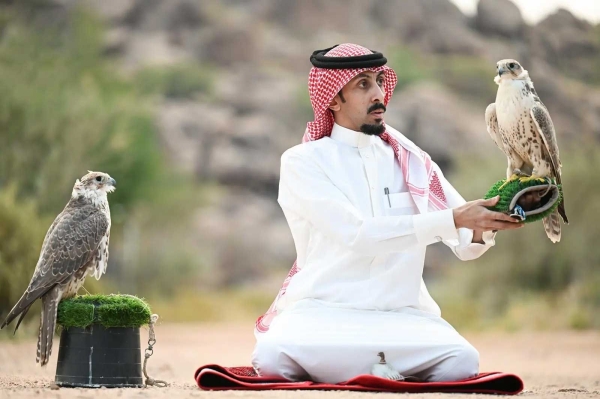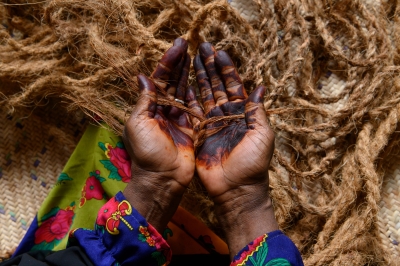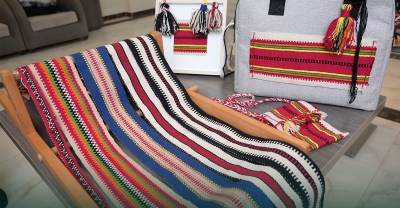

Falconry, also known as al-Bayzarah, in the Kingdom of Saudi Arabia, is one of the Kingdom's traditional crafts involving falcon breeding and training on hunting and catching. It requires patience and caution. The training process takes thirty to forty days. Falconry focuses on birds' migratory routes and pathways. It is practiced by people of all ages, whether men or women, amateurs or professionals.
Importance of falconry
Falconry is a national symbol and a historical tradition in the Kingdom. It is a hobby and identity deeply rooted in Arab culture, with a strong passion for hunting among Saudis. Some even name their children after falcons out of admiration for them and their strength.
The Kingdom's geographical location, occupying nearly two-thirds of the Arabian Peninsula and serving as a geographical connection between three continents, has endowed it with unique environmental features that attract various marine, terrestrial, and avian life species. Archaeological evidence of falcons dating back over 9,000 BCE has been discovered between Tathlith Governorate in Aseer Province and Wadi ad-Dawasir Governorate south of Riyadh City. Artifacts found in the area indicate symbols of authentic Arab culture, including horsemanship, falconry, and the use of saluki dogs for hunting.
Falcons used in falconry
There are various types of falcons, differing in shape and color. Falconry enthusiasts in the Kingdom agree on three main types, with the saker falcon (Falco cherrug) being the most prominent. Saker falcons have been known to the Arabs since ancient times. They are considered one of the best and most resilient types of falcons, known for their patience, ability to withstand hunger, resistance to diseases, and beautiful appearance. It is also famous for its at-Tal'ah (take-off) among falconers, which refers to its incredible speed, reaching up to three hundred km/h. Other types include the peregrine falcon (Falco peregrinus) and the mountain peregrine falcon.
Falconry enthusiasts in the Kingdom import various types of falcons, with the saker and peregrine falcons being the most sought-after, along with purebred birds of each type. Although there are faster species, Saudi falconers tend to the saker falcon for its patience and endurance.
Falcons of all types, including the peregrine, saker, lanner falcon (Falco biarmicus), and gyrfalcon (Falco rusticolus), breed once a year, producing two to five falcon chicks. (Ancient) Arabs named these chicks al-Nadir, referring to the strongest and largest; al-Wasat, smaller than al-Nadir; and al-Mahqoor, the smallest and the weakest. The mother incubates them for approximately thirty-two days inside the nest known as al-Makir.
Falcons owned by hunters in Saudi Arabia
The number of falcons owned by hunters in the Kingdom is approximately 16,000 with the number of falconers reaching twenty thousand. The falcon is classified as a hunting bird of prey alongside the eagle and the hawk. Arabs were the first to train and use falcons for hunting.
Falcons are distinguished from other birds of prey by their dark eyes, speed of up to three hundred km/h when diving for prey, and sharp vision, which is four to eight times sharper than humans. A falcon can live up to twenty-five years in the falconer's care, while it can live up to fifteen years in the wild.
Migration of falcons
The Kingdom serves as a passage for many migratory birds, including falcons. Every year, birds of prey migrate from their nesting areas in distant regions, such as the northernmost part of Russia (Siberia), to the warmer parts of Africa, covering a distance of about eight thousand km. Around 1.5 million birds, including falcons of both types— peregrine and saker falcon—pass through the Kingdom's airspace each year during October, while some falcons inhabit the Kingdom, such as the mountain peregrine falcon and the lanner falcon.
As part of its efforts to preserve wildlife, the Kingdom prohibits hunting the saker falcon, mountain peregrine falcon, and lanner falcon to help restore the natural balance of these falcons, which are at risk of extinction.
Organization of falconry in Saudi Arabia
Driven by the deep connection between falcons and the Kingdom's history, heritage, and culture, the Saudi Falcons Club, the first Saudi club dedicated to preserving the craft of falconry, was established in 2017 by a Royal Decree. The club is overseen by the Crown Prince and Prime Minister, His Royal Highness Prince Mohammed Bin Salman Bin Abdulaziz Al Saud. It aims to unite falconers under one organization, care for falcons, and support related activities.
The Kingdom has also joined international agreements to protect falcons from extinction and safeguard migratory birds. Among these is the Convention on International Trade in Endangered Species of Wild Fauna and Flora (CITES), which the Kingdom joined in 1996.
Registration of falconry in UNESCO
On November 16, 2010, the Intergovernmental Committee for the Safeguarding of the Intangible Cultural Heritage officially inscribed falconry, or "hunting with falcons," on the UNESCO Intangible Cultural Heritage List, based on a proposal by several member states in the organization, including the Kingdom.
Falconry events
The Saudi Falcons Club organizes several falconry activities, including the King Abdulaziz International Falconry Festival, the International Falcon Breeders Auction (IFBA), the International Saudi Falcons and Hunting Exhibition, Melwah Racing, the Saudi Falcon Club Auction, and the Saudi Falcons and Hunting Exhibition.
Related quizzes
Related articles

